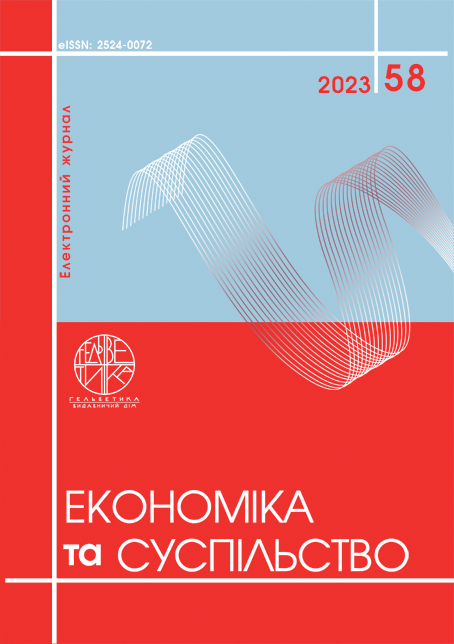FEATURES OF DEVELOPMENT OF THE OF THE IT/IC SECTOR IN EASTERN EUROPE
Abstract
The article comprehensively analyzes the information and telecommunications sector, focusing mainly on Eastern European countries. Examining various indicators, such as ICT value-added, labor force dynamics, educational components, and ICT exports, sheds light on this sector's status and trends. A detailed comparison of Eastern European countries and specific nations within the region serves as the basis for the analysis. The study delves into the ICT value-added indicator, elucidating how different countries fare regarding their contributions to the sector. Specifically, it offers insights into Azerbaijan, Georgia, and Moldova, providing a nuanced understanding of their respective positions. Over seven years, the article observes positive dynamics in the labor force indicator within the information and telecommunications sector. It highlights the growth and changes in this aspect, indicating a promising trajectory for the industry. Furthermore, the educational component is thoroughly explored, focusing on the number of students and graduates in ICT specialties across the region. To gauge the effectiveness of the ICT sector within each country, the analysis considers the ICT export indicator. By studying this metric, readers gain valuable insights into these nations' international presence and competitiveness in the ICT market. Additionally, a deeper examination of the technology segment of the sector offers a more nuanced understanding of its functioning. One notable observation is the reorientation of the export indicator between technological and telecommunications directions within the ITC sector. This shift underscores evolving trends and priorities within the industry, reflecting changes in global demand and technological advancements. The article highlights varying degrees of development and dynamics among Eastern European countries. While Georgia and Moldova exhibit more similar trajectories in their ICT indicators, Azerbaijan faces certain challenges, with stagnant estimates of ICT development in comparison. These differences allow for further exploration of the factors underlying these differences in the following studies.
References
Abasova, S. Analysis and assessment of ICT innovations impact on competitiveness of foreign economic relations: Azerbaijan’s experience. Technology Audit and Production Reserves. 2022. Vol. 5, № 4(67). Р. 29–36. DOI: https://doi.org/10.15587/2706-5448.2022.268042
Huseynova, A., Mazanova, O. The Leading Role of Digital Technologies in the Development of the Smart City Concept in Azerbaijan (2022070050). 2023. Preprints. DOI: https://doi.org/10.20944/preprints202207.0050.v2
Bickauske, D., Simanaviciene, Z., Samorodov, B., Kromalcas, S. Digital transformation and increasing Moldova industry SWOT analysis. Financial and Credit Systems: Prospects for Development. 2022. № 2(5). Р. 56–67. DOI: https://doi.org/10.26565/2786-4995-2022-2-06
Arendt, Ł. (2015). The Digital Economy, ICT and Economic Growth in the CEE Countries. Olsztyn Economic Journal. 2015. № 10(3). Р. 247–262. DOI: https://doi.org/10.31648/oej.3150
Lengyel, B. The Hungarian ICT Sector: A Comparative CEE Perspective with Special Emphasis on Structural Change. In P. J. J. Welfens (Ed.), Clusters in Automotive and Information & Communication Technology: Innovation, Multinationalization and Networking Dynamics. Springer, 2012. Р. 59–85. DOI: https://doi.org/10.1007/978-3-642-25816-9_2
Future of IT Report 2023. Emerging Europe. URL: https://646395.fs1.hubspotusercontent-na1.net/hubfs/646395/Reports%202023/Emerging%20Europe%20Future%20of%20IT%20Report%202023.pdf
The Future of IT: Landscape Report 2022. Emerging Europe. URL: https://emergingeurope.myshopify.com/products/the-future-of-it-landscape-report-2022-free
Information Society. The State Statistical Committee of the Republic of Azerbaijan. URL: https://www.stat.gov.az/source/information_society/?lang=en
Information and Communication Technologies (ICTs) sector in Georgia. April 2023. URL: https://pmcresearch.org/publications_file/2120642a909c265ad.pdf
Economic statistics. Biroul National de Statistica al Republicii Moldova. URL: https://statbank.statistica.md/PxWeb/pxweb/en/40%20Statistica%20economica/?rxid=b2ff27d7-0b96-43c9-934b-42e1a2a9a774
Social statistics. Biroul National de Statistica al Republicii Moldova. URL: https://statbank.statistica.md/PxWeb/pxweb/en/30%20Statistica%20sociala/?rxid=b2ff27d7-0b96-43c9-934b-42e1a2a9a774
Abasova, S. (2022). Analysis and assessment of ICT innovations impact on competitiveness of foreign economic relations: Azerbaijan’s experience. Technology Audit and Production Reserves, vol. 5, no. 4(67), 29–36. DOI: https://doi.org/10.15587/2706-5448.2022.268042
Huseynova, A., & Mazanova, O. (2023). The Leading Role of Digital Technologies in the Development of the Smart City Concept in Azerbaijan (2022070050). Preprints. DOI: https://doi.org/10.20944/preprints202207.0050.v2
Bickauske, D., Simanaviciene, Z., Samorodov, B., & Kromalcas, S. (2022). Digital transformation and increasing Moldova industry swot analysis. Financial and Credit Systems: Prospects for Development, 2(5), 56–67. DOI: https://doi.org/10.26565/2786-4995-2022-2-06
Arendt, Ł. (2015). The Digital Economy, ICT and Economic Growth in the CEE Countries. Olsztyn Economic Journal, 10 (3). 247–262. DOI: https://doi.org/10.31648/oej.3150
Lengyel, B. (2012). The Hungarian ICT Sector: A Comparative CEE Perspective with Special Emphasis on Structural Change. In P. J. J. Welfens (Ed.), Clusters in Automotive and Information & Communication Technology: Innovation, Multinationalization and Networking Dynamics. Springer. DOI: https://doi.org/10.1007/978-3-642-25816-9_2
Emerging Europe (2023). Future of IT Report 2023. Available at: https://646395.fs1.hubspotusercontent-na1.net/hubfs/646395/Reports%202023/Emerging%20Europe%20Future%20of%20IT%20Report%202023.pdf
Emerging Europe (2023). The Future of IT: Landscape Report 2022. Available at: https://emergingeurope.myshopify.com/products/the-future-of-it-landscape-report-2022-free
The State Statistical Committee of the Republic of Azerbaijan (2023). Information Society. Available at: https://www.stat.gov.az/source/information_society/?lang=en
Pmcresearch (2023). Information and Communication Technologies (ICTs) sector in Georgia. Available at: https://pmcresearch.org/publications_file/2120642a909c265ad.pdf
Biroul National de Statistica al Republicii Moldova (2023). Economic statistics. Available at: https://statbank.statistica.md/PxWeb/pxweb/en/40%20Statistica%20economica/?rxid=b2ff27d7-0b96-43c9-934b-42e1a2a9a774
Biroul National de Statistica al Republicii Moldova (2023). Social statistics. Available at: https://statbank.statistica.md/PxWeb/pxweb/en/30%20Statistica%20sociala/?rxid=b2ff27d7-0b96-43c9-934b-42e1a2a9a774

This work is licensed under a Creative Commons Attribution 4.0 International License.


